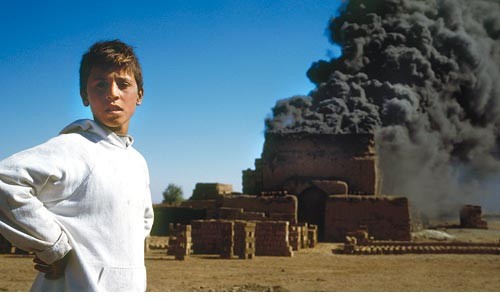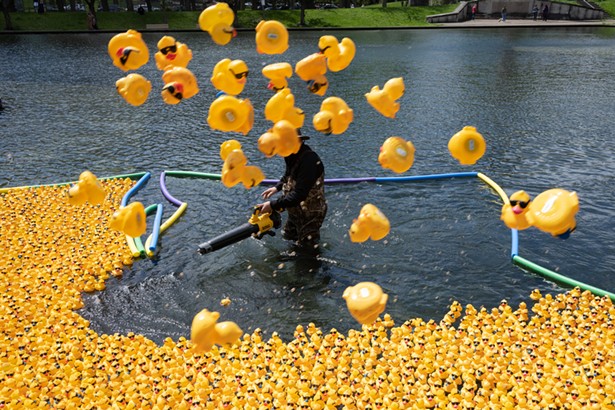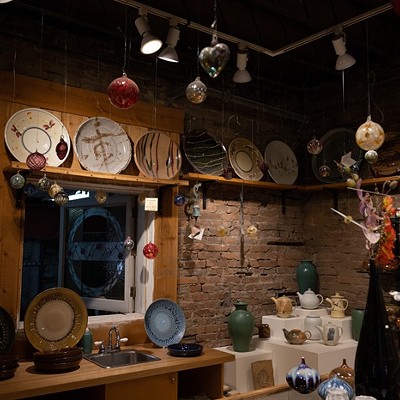America's Iraq debate centers on pulling out U.S. troops, whose casualties are closely tracked. The much larger number of Iraqis who've died in the multinational and civil conflicts that followed the U.S. invasion of March 2003, estimated at 100,000 or more, is officially regarded as not worth knowing, and relegated in the press to secondary mention. Also of limited interest are the struggles of Iraqis still living. Indeed, empathetic to Iraqis though they may be, even the better documentaries from post-invasion Iraq (Gunner Palace, The War Tapes) typically focus on how American servicepeople are faring.
A stunning exception has arrived. Iraq in Fragments is the film's name, and also its structure and theme. James Longley, a young American working alone but for his translators, shot it in the two years following the U.S. invasion. Longley's commitment is clear in the startling intimacy he achieves with his subjects, chiefly an 11-year-old Baghdad auto-shop apprentice; a militant young Shiite cleric; and a pair of families in rural Kurdistan.
Longley's ballsy sojourn one day made him witness to an armed and violent Shiite militia raid. Yet he was searching not for danger, but for Iraq's people, and their stories. Such was the time he spent, and the trust he gained, that the beautifully photographed Iraq in Fragments plays more like neorealism -- a fictional portrait or narrative using nonactors -- than documentary.
Longley's people and places, though, are wholly, poignantly, messily and sometimes frighteningly real. Most keenly sympathetic is pre-teen Mohammed, a timid, dark-eyed boy whose Baghdad Longley renders as the space between rumbling tanks, chattering military choppers and dark smoke billowing from the latest target on the horizon.
Mohammed's world is further circumscribed by his boss, the garage owner who helped raise him after his father, a political prisoner under Saddam Hussein, disappeared. "He's nice to me," says Mohammed. Except that the man's moments of affection are offset by cruel putdowns, and an autocrat's general irritation at the slowness of a kid who's four years older than his fellow first-graders.
If the shadow of politics plays only at the fringes of Mohammed's story, it's fully realized in "Sadr's South." The kid's-eye-level camera and wrenching close-ups that framed Mohammed give way to teeming group shots as Longley visits Nasiriyah and Najaf and followers of Shiite cleric Moqtada al-Sadr. Oppressed under Saddam, fervent Shiites now give full voice to their revolutionary fervor. Sheik Aws al Kafaji -- he's 32, about Longley's age when he finished shooting Iraq in Fragments -- was once imprisoned for challenging the regime. Now he's a militant preacher, presiding over meetings of the pious for prayer, flag-waving and ritual self-flagellation.
Viewers used to only quick sketches of militants who loathe both the then-imprisoned Saddam and the U.S. occupiers who jailed him will find the sheik's brethren complex as well as unnerving. These are the months following the revelations about prisoner abuse at Abu Ghraib, and leading to a general election in which Shiites hope to dislodge authorities hand-picked by Washington. Killing, displacement, torture, arrest without charge -- this is the gift of Western democracy, says the preacher. Then Longley, harrowingly, shows masked and armed Shiite militiamen raid a market over rumors of impious alcohol sales. Suspects are beaten, blindfolded and detained. Their captors seem prepared to hold them indefinitely.
Legitimate Shiite grievances about the occupation's fecklessness ("Where is the money they are squandering?") don't excuse fundamentalist vigilante justice. But in the new Iraq, nothing's simple. Shiites march with the coffins of gunned-down protesters; "If America leaves," an Iraqi voice says of the Shiites, "these people will be like the new Saddam."
If Mohammed's world is chopped into moments, and Sadr's South into shards, the Kurdistan of "Kurdish Spring," the final section of Longley's triptych, is a relative paradise: Rural, uncluttered, the great funnel of black smoke in the sky not a sign of the charred debris of war but the peaceful burn-off from a local brick oven. Two boys frolic in a sunflower patch, and learn English in school; a central figure is a scholarly looking old shepherd.
But don't be lulled by Longley's gorgeous golden-hour landscapes. The Kurds, who long for their own nation, cite historical grievances including Saddam's Anfal campaign, which killed some 100,000 of their number. As they prepare to vote, there are sermons on casting ballots and complaints about their own leaders. Longley documents a polling place barely kept from chaos by soldiers. "If there is religion left it is among the Kurds," says one interview subject, in voiceover. "God brought America to the Kurds," says another.
Iraq, says an elderly voice in this last section, will be in three pieces.
"How can you cut a country in pieces?" says a child's voice Longley edits in right after.
Iraq in Fragments is conspicuous for its lack of women, only two of whom speak: a Kurdish schoolteacher and a young woman defending in vain her husband's innocence to the Shiite militiamen who have seized him. That too, as much as any demonstration Longley shot, seems part of the identity of a country whose future -- whose next week -- is completely uncertain. And Longley's Iraqis cling to it: Was Longley thinking metaphorically, about a nation, when he edited in a Kurdish boy saying, of his father: "He raised all of us. Shouldn't we take care of him now?" In Arabic and Kurdish, with subtitles. 
Starts Fri., Jan. 19. Regent Square















